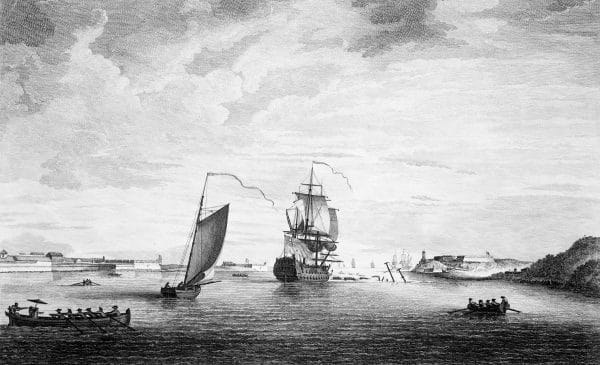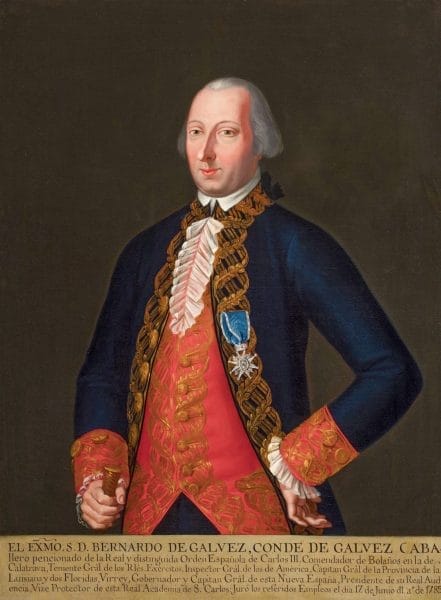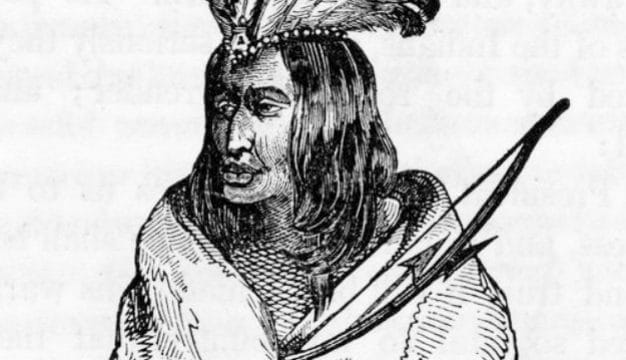Elias Durnford
 Elias and Rebecca Walker Durnford
Colonial administrator, planter, artist, and British army officer Elias Durnford (1739-1794) played important roles in the founding, formation, and fall of the colony of British West Florida (encompassing the present-day Florida panhandle, the lower half of both Alabama and Mississippi, and eastern sections of lower Louisiana). Born on June 13, 1739, in the Hampshire village of Ringwood, in Great Britain, Durnford joined the British army’s corps of engineers as an ensign on March 17, 1759. He served at the siege of Belle Isle, off the coast of France, in the Seven Years’ War in 1761, and at the siege of Spanish Havana in 1762 with such distinction that the British commander there, Lord Albemarle, made him an aide de camp, a high honor in the British military. Durnford was also an accomplished artist, and engravings of his sketches from Cuba today sell for thousands of dollars.
Elias and Rebecca Walker Durnford
Colonial administrator, planter, artist, and British army officer Elias Durnford (1739-1794) played important roles in the founding, formation, and fall of the colony of British West Florida (encompassing the present-day Florida panhandle, the lower half of both Alabama and Mississippi, and eastern sections of lower Louisiana). Born on June 13, 1739, in the Hampshire village of Ringwood, in Great Britain, Durnford joined the British army’s corps of engineers as an ensign on March 17, 1759. He served at the siege of Belle Isle, off the coast of France, in the Seven Years’ War in 1761, and at the siege of Spanish Havana in 1762 with such distinction that the British commander there, Lord Albemarle, made him an aide de camp, a high honor in the British military. Durnford was also an accomplished artist, and engravings of his sketches from Cuba today sell for thousands of dollars.
After the war, Durnford became chief engineer and surveyor general of the new colony of West Florida thanks to the patronage of Lord Harcourt. In addition to his modest annual salary, Durnford also earned money for every 100 acres he or his assistants surveyed, which greatly enhanced his income, as land grants of thousands of acres were commonplace in West Florida. Durnford’s personal holdings totaled 52,662 acres, the jewel of which was his 5,000-acre plantation, Belle Fontaine, set on the cliffs above Mobile Bay’s eastern shore. Located near present-day Montrose, the area was free from the fevers and crowding that plagued Mobile and was also home to Crofton, a military convalescent hospital. As chief engineer, Durnford drew detailed plans for rebuilding the port there, but they were never implemented. He had more success in designing a road, which was partially built, linking Mobile and the colony’s capital, Pensacola.
 Elias Durnford Drawing
Upon the death of West Florida governor John Eliot in 1769, Durnford sailed for England, where he was named lieutenant governor of West Florida, and on August 25 he married Rebecca Walker, with whom he had five sons and four daughters. The couple then sailed for British West Florida, where Durnford served as acting governor until the arrival of the new governor, Peter Chester, on August 10, 1770. Durnford took up his duties as lieutenant governor and remained influential as a member of the West Florida Council, which functioned as a cabinet and as the upper house of the colony’s legislature. Between 1766 and 1778 Durnford missed only one of its meetings.
Elias Durnford Drawing
Upon the death of West Florida governor John Eliot in 1769, Durnford sailed for England, where he was named lieutenant governor of West Florida, and on August 25 he married Rebecca Walker, with whom he had five sons and four daughters. The couple then sailed for British West Florida, where Durnford served as acting governor until the arrival of the new governor, Peter Chester, on August 10, 1770. Durnford took up his duties as lieutenant governor and remained influential as a member of the West Florida Council, which functioned as a cabinet and as the upper house of the colony’s legislature. Between 1766 and 1778 Durnford missed only one of its meetings.
When the American Revolution broke out, Durnford’s duties became increasingly military in orientation. In 1779, his military role became even more prominent when Spain entered the fray as an ally of France (which was allied with the Americans), thus joining the seemingly endless wars with Great Britain over colonial territories in the Americas. In January 1780, Durnford took command of Mobile’s Fort Charlotte, a crumbling brick edifice built by the French as Fort Condé. On February 10, a sizable Spanish force anchored in Mobile Bay.
Durnford’s garrison, a motley collection of sailors, resident volunteers, armed enslaved people, and regular troops totaled 287. Francisco Bouligny, emissary from the Spanish camp of 2,000 men, met with Durnford and demanded his surrender, which he fully expected to receive given the imbalance of forces. Durnford, however, was awaiting a relief force from British Pensacola and refused. An exchange of wine and cigars between the enemy commanders accompanied continued polite negotiations, even as the Spanish dug trenches and sited siege cannons under the direction of José Manuel de Ezpeleta.
 Bernardo de Gálvez
The old bricks of the fort could not withstand the pounding from the Spanish artillery. During the short campaign, Belle Fontaine also was razed. On March 10, the besieged British garrison ran a white flag above the fort. As the price of surrender Durnford demanded that the victors afford his garrison the honors of war and refrain from any retaliation against the townsfolk of Mobile. The Spanish commander in chief, Bernardo de Gálvez, agreed but stipulated that he would treat armed colonists in the garrison as prisoners of war. The Spanish troops entered Fort Charlotte in August 1780.
Bernardo de Gálvez
The old bricks of the fort could not withstand the pounding from the Spanish artillery. During the short campaign, Belle Fontaine also was razed. On March 10, the besieged British garrison ran a white flag above the fort. As the price of surrender Durnford demanded that the victors afford his garrison the honors of war and refrain from any retaliation against the townsfolk of Mobile. The Spanish commander in chief, Bernardo de Gálvez, agreed but stipulated that he would treat armed colonists in the garrison as prisoners of war. The Spanish troops entered Fort Charlotte in August 1780.
Gálvez completed his conquest of West Florida in 1781 by taking Pensacola. Durnford returned to Britain with his family but resumed his military career in the 1790s, taking part in campaigns against the French in Martinique, Guadaloupe, and St. Lucia. Durnford died in Tobago from yellow fever on June 21, 1794.
Further Reading
- Fabel, Robin F.A. The Economy of British West Florida, 1763-1783. Tuscaloosa: University of Alabama Press, 1988.
- Hamilton, Peter J. Colonial Mobile. 1910. Reprint, Tuscaloosa: University of Alabama Press, 1976.
- Howard, Clinton N. The British Development of West Florida, 1763-1769. Berkeley: University of California Press, 1947.
- Johnson, Cecil. British West Florida, 1763-1783. New Haven, Conn.: Yale University Press, 1942.
- Starr, J. Barton. Tories, Dons, and Rebels: The American Revolution in British West Florida. Gainesville: University Presses of Florida, 1976.



